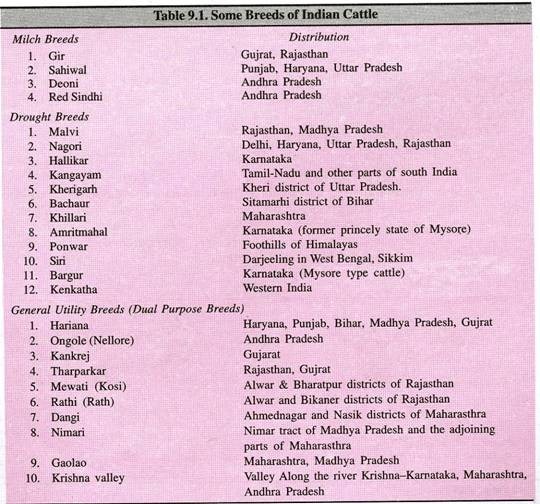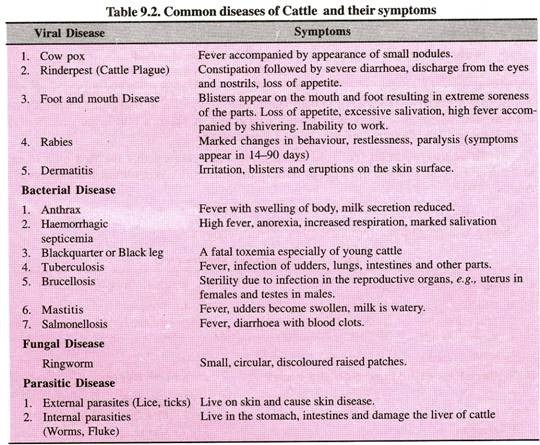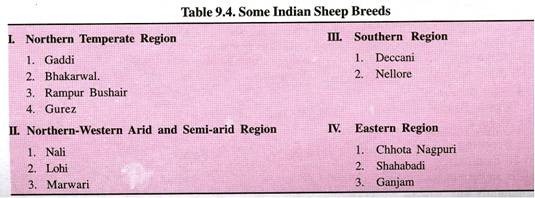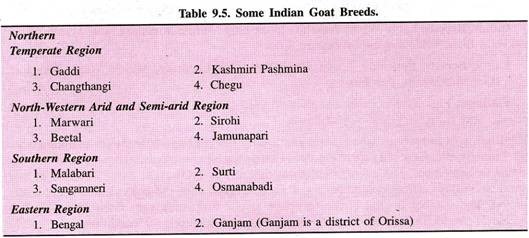Some common methods of breeding of cattle, buffaloes, sheep, goats, pigs, horses, donkeys, mules, camels, etc. are described below.
Contents
1. Cattle (Bos indicus):
Selection:
Mature cattle having more than 3 years of age should be used for breeding.
Methods of Breeding:
There are two methods of cattle breeding: natural breeding and artificial insemination.
1. Natural Breeding:
It may be random or controlled.
Heat:
The oestrus (heat period) in the female lasts for 12-24 hours. The average gestation period for the cow is 280 days.
2. Artificial Insemination (AI):
It involves the insemination of the semen of superior bulls of exotic or indigenous breeds into the native cows. The inseminating pipette is carefully inserted into the cervix through vagina.
The semen should be deposited either deep in the cervix or at the beginning of the body of the uterus. Semen from desired bull located at distant places can be used. The spread of certain diseases can be controlled by this method.
Artificial insemination was first introduced in India at Indian Veterinary Research Institute, Izatnagar, near Bareilly, Uttar Pradesh.
Super Ovulation and Embryo Transplantation:
Generally one ovum is released from each ovary at the time of ovulation. But by hormone injection, more ova can be produced from the ovary. After artificial insemination 4 to 10 embryos are collected at a time. Then each embryo is transplanted into a surrogate mother “carrier cow”. At very low temperature foetuses can be preserved for several days.
Breeds of Cattle:
The cattle breeds are classified into three groups.
(i) Milch Breeds:
The cows of these breeds are good milk producing, however, bullocks are of poor quality.
(ii) Drought Breeds:
The bullocks of these breeds are good for working but cows are poor milk producers.
(iii) General utility Breeds (Dual-purpose Breeds):
The cows of these breeds are good milk producers and the bullocks are good draught animals. They are intermediate between milch and drought breeds.
New Breeds:
(1) Karan Swiss:
This breed has been evolved at the National Dairy Research Institute, Kamal in Haryana, by breeding the Sahiwal cows with the semen of Brown Swiss bulls imported from U.S.A.
(2) Sunandini:
This breed originated in Kerala by crossing the local non-descript cattle with Jersy, Brown Swiss and Holestein-Friesian breeds.
(3) Karan Fries:
The breed has got its origin at the National Dairy Research Institute Kamal, out of crossing between Tharparkar and Holstein Friesian.

Lactation in sterle cows is induced by stibesterol.
Cattle Diseases:
2. Indian Buffalo (Bubalus bubalis):
Breeds of Indian Buffaloes:
There are seven breeds of buffaloes in India. The best known breeds of Indian buffaloes are the Murrah, Jaffarabadi, Nili, Bhadawari and Surti.
Sexual Maturity:
(i) Male. In India, Pakistan and Egypt the buffalo bull is generally not used as stud before 3 to З 1/2 years of age. (ii) Female. It appears that in general, buffalo heifers are not bred before they are 2 1/2 – 3 years of age.
Artificial Insemination (A.I.):
In India, it has been claimed that the first buffalo calf in the world bred by means of A.I. was born in the Allahabad Agricultural Institute on 21st August, 1943.
3. Sheep (Ovis aries):
Sheep is a gregarious, ruminant often homed mammal.
Some Exotic Breeds of Sheep:
(1) Merinos. It is the most popular fine wool breed.
(2) Rambouillet
(3) Suffolk
(4) Dorset
(5) Corriedale
(6) Southdown
(7) Lincoln and
(8) Leicester.
Breeding of Sheep:
Sheep normally mature at about 2 years old. In India there are three main mating seasons, viz., March to April, June-July and September-October. The average heat period is 30 hours. The Sheep, gestation period varies from 142-152 days with an average of 150 days.
Artificial Insemination (A.I.) in sheep has played an important role in improving sheep breed within a short period in Russia and in some European Countries.
Diseases of Sheep:
These include haemorrhagic septicaemia, anthrax, foot and mouth disease, sheep pox, black quarter, rinderpest, diarrhoea, fascioliasis and coccidiosis. The sheep also suffer from external parasites like ticks, lice and mites.
4. Goat (Capra capra):
Goat is called the poor man’s cow. The goat is usually hollow-horned and bearded ruminant mammal. It has strong smelling power. It can readily adopt to almost any climate.
Exotic Breeds of Goats:
(1) Alpine.
(2) Toggenberg.
(3) Saanen.
(4) Nubian and
(5) Angora.
Breeding of Goats:
For getting good results, goats should be bred at the age from 14 to 18 months. The duration of oestrus or heat period is usually 24 to 28 hours but it may differ in certain breeds. The gestation period is from 145-153 days (5 months). Indian goat commonly kid twice in one year and usually three times in two years.
In does, a peculiar behaviour has been observed where occasionally accept the male even when they are pregnant. The goat gives birth while lying down. Male kids, not required for breeding, should be castrated before 10 to 12 weeks old. Under ordinary conditions, the average life of goat is about 12 years.
Pashmina wool is obtained from the mountain goat. This animal is found in Ladakh and Tibet.
Diseases of Goats:
Goats suffer from some contagious diseases (diseases which spread by touch) such as goat pox, anthrax, pleuropneumonia and foot and mouth disease. Parasitic infection is also common in goats. Infected goats should be isolated. Vaccination of healthy animals is essential.
5. Pigs (Sus scrofa):
Pig is also called swine or hog. It is an omnivorous, non-ruminant, gregarious mammal. The European breeds of domestic swine were derived from the local wild pig, Sus scrofa, whereas the breeds in the far Eastern parts of the globe were derived from another wild pig. Sus vittatus. The modern breeds of pig evolved from different crossings between the two original types. The present day domestic pig, Sus domesticus is the result of several years of evolution through gradual domestication.
Breeds of Pig:
There are about 60 recognised breeds of domestic pigs in the world.
Indian Breeds:
Large-White Yorkshire Boar, Large-White Yorkshire Sow, Middle White Yorkshire Boar, Middle White Yorkshire Sow.
Exotic Breeds:
Berkshire, Large White Yorkshire, Landrace, Middle White Yorkshire, Hampshire, Tamworth and Wessex.
Wallows:
Pigs have poor heat-regulating mechanism as they sweat only on the snout, because they have very few sweat glands.
Boar is fit for service when it is 1 year old. A gill becomes ready for breeding when it is 9 months old. Generally there are two seasons for breeding pigs. February to March and August to September. The average length of the oestrus cycle is 21 days.
Duration of heat period is 2-3 days. The gestation period of pig averages about 114 days (3 months, 3 weeks, 3 days). The number of piglets they produce at one birth may vary from 10 to 12. It is capable of producing two litters per year under good management conditions.
Diseases of Pigs:
These include swine fever, swine-pox, foot and mouth disease swine plague, tuberculosis, infectious dysentery. Swine influenza, anthrax and piglets influenza. Swime parasites also cause some diseases:
(i) Mite (Sarcoptes suis) causes sarcoptic mange— a skin disease,
(ii) Lice— they may be responsible for spread of other infections, irritation,
(iii) Round worms— cause heavy losses every year due to the development of pot belly and general weakness,
(iv) Trichinella spiralis— a nematode, causes Trichinosis disease. Its symptoms are muscular pains, low fever, etc.
6. Horses (Equus caballus):
The average age of puberty in a filly is 15 to 24 months but she should not be bred before 3 years of age. Stallion attains maturity at 4.5 to 5 years of age. Early spring is the best breeding season for horses in India. A stallion can serve 30 to 40 mares. Female comes into heat every 21 days. Duration of heat period varies from 7-9 days. The most suitable time for a mare to breed is late as in the heat period. The signs of heat are as in the cow.
The gestation period is 340 days. The mare produces a single foal at each birth. The mares usually give birth when lying down. The ‘after birth’ is passed out in an hour or two. After delivery, the mare should be given a drink of lukewarm water and branmash. The clostrum is healthy for the new-born. Foals are weaned when they are 5 to 6 months old.
7. Donkeys (Equus asinus):
There are two breeds of donkeys in India :
(i) Small, dark grey and large, light grey. They occur in most parts of India,
(ii) White donkey are also called wild ass. They occur in Rann of Kutch. There is no particular breeding season, therefore, they can breed throughout the year. The female comes into heat every 21 to 28 days. The heat period is from 3 to 7 days. The optimum time for mating is the third day of heat. The gestation period is 11.5 to 12 months. Generally one young is born at a time.
8. Mules:
A mule is a hybrid of male donkey (Jack) and a female horse (mare). It inherited size and intelligence from the horse and firm footedness, great tolerance and ability to live on rough food from the donkey. However, with all its hybrid vigour the mule is sexually sterile {i.e., unable to reproduce) and have to be produced every time a new. The hybrid between the female ass and stallion (male horse over 3 years old) is called hinny which is also sterile.
9. Camels:
Camels breed only during winter months (November to March). The male may attain sexual maturity at 3 years of age but his full reproductive capacity is not developed up to 6 years. An adult male may serve 50 females on an average during single breeding season.
The She-camel attains sexual maturity at about 3 years of age but usually they are bred during 4 years of age, Normally a She-Camel can be bred up to 20 years of age and some respond even till 30 years. Oestrous cycle in camel of Rajasthan varies from 22 to 24 days with an average of 23 days. The oestrous (heat) lasts for 3 to 5 days.
Types of Camels:
Camels are of two types.
(i) Arabian Camels (Camelus dromidaris):
They have a single hump, short hair and are found in North Africa to India. They do not occur in wild state.
(ii) Bactrian Camels (Camelus bactrianus):
They have two humps, long hair and found in Gobi desert of Central Asia. They also occur in wild form. Bactrian camels also occur in Ladakh (part of J & K, India).
Indian Breeds of Camels:
(i) Bikaneri:
They are found near Bikaner, Rajasthan and have good height, strong inbuilt and active habits.
(ii) Jaisalmeri:
The animals are shorter and lighter than Bikaneri and found near Jaisalmer, Rajasthan.
(iii) Mewari:
This breed is native of Mewar area of Rajasthan. The animals are stouter and little shorter than Bikaneri.
(iv) Sindhi:
The camels of this breed are found in Rajasthan. Originally this breed is from Sindh.
(v) Kutchi:
This breed of camels is found in Kutch area of Gujarat.
Camel gets water regularly from the oxidation of fat present in the hump.
Diseases of Camels:
The common diseases of camels are Trypanosomiasis, (Surra), Anthrax, Camel pox, Pneumonia, Rabies and Jhooling.
10. Elephant:
Elephant is the largest land animal which becomes sexually mature at the age of 8 to 16 years. It has a long gestation period of 22 months and lives up to hundred years. Tamed elephant is employed in transport, hauling of longs, hunting, circus, etc. Elephant is a source of ivory, which is obtained from tusks which are long, protruded upper incisors. There are three species of elephants.
(i) Indian Elephant (Elephas maximus):
It has small ears, high domed forehead and convex back; tusks are only in male but not always. It can be trained easily.
(ii) African Elephant (Loxodonta africana):
It has large ears, convex sloping forehead. Tusks in both sexes. It is difficult to train.
(iii) Pigmy (Pygmy) African Elephant (Elephas cyclotis):
It is much smaller than other two types of elephants.
11. Yak:
Yak is found in Tibet, Ladakh, Garhwal, Kumaon, Sikkim, Lahaul and Spiti. The yak is highly adapted to cold climates
of the Himalayas. It gives meat, hide and wool. The transport of people and goods in these regions would be impossible without this animal. The yak is also used for ploughing the land.











